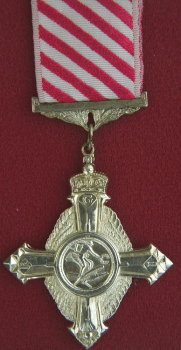
AIR FORCE CROSS (AFC)
TERMS
The cross is awarded to an officer or a Warrant Officer for an act
or acts of valour, courage or devotion to duty whilst flying, but not while
in active operations against an enemy.
BAR
A bar is awarded for an additional act which would have warranted the
AFC. The straight slip-on silver bar has an eagle in the centre. The year
of the award is engraved on the reverse.
DESCRIPTION
A silver cross (1.625" across), shaped as a thunderbolt in the form
of a cross, the arm terminates with a bomb. The cross is surmounted by
another cross composed of aeroplane propeller blades, with the ends of
the four blades enscribed with the Royal Cypher. For the WWII DFCs the
letters G (top), R (left), VI (bottom), and I (right) and for the Korea
DFCs E (top), II (left), R (right), and the bottom blank. The top arm is
ensigned by an Imperial Crown.
OBVERSE
In the centre of the obverse is a roundel displaying Hermes, mounted
on a hawk in flight, bestowing a wreath.
REVERSE
Within a central circle, the current Royal Cypher (GV, GVI, EIIR) above
the date 1918. The year of award appears on the lower arm.
MOUNTING
A small link at the top of the crown attaches to a slot in two sprigs
of laurel firming the underside of a straight clasp.
RIBBON
The ribbon is 1.25 inches wide, and consists of alternating red and
white stripes (0.125 wide) leaning to the left at 45 degrees from the vertical.
The red colour is to appear in the bottom left and upper right corners
when viewed on the wearer's chest. Until 1919, the stripes were horizontal.
NAMING
The medals are issued unnamed.
DATES
The award was established on 03 June 1918, the birthday of King George
V.
~Squadrons~ ~Order of Battle~ ~Airfields~ ~Aircraft~ ~Daily Operations~ ~Stats~ ~Strike Photos~ ~Mining Codes~ ~Home~ ~Sign My Guestbook~ ~View My Guestbook~